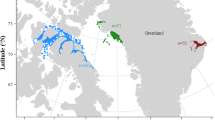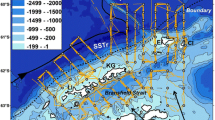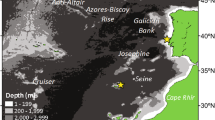Abstract
Global warming is predicted to reduce the amount of sea ice concentration in polar environments, thus presenting profound changes for populations of seabirds and marine mammals dependent on sea ice. Using data from a shipboard survey during August 2012, I test the hypothesis that relative abundance of seabird and marine mammals reflects environmental variability associated with the dynamic pack ice zone. Using environmental data and observations of sea ice concentration, I quantified an environmental gradient that describes the spatial organization of the dynamic pack ice zone. The relationship of top predators to this environmental gradient revealed three important aspects: (1) an open water and pack ice community is present with some top predator species exhibiting higher abundance associated with moderate sea ice concentration (40–60 %) as opposed to the pack ice edge (10 %), (2) Antarctic fur seals (Arctocephalus gazella) were the most abundant pinniped and they were observed resting on ice floes and foraging within leads and polynyas, and (3) for the most abundant species, spatial regression models indicate that latitude and sea ice concentration (a principal north/south gradient) are the most important environmental determinants. Winter ocean conditions may strongly influence population dynamics of top predators; therefore, information regarding their habitat use during winter is needed for understanding ecosystem dynamics.







Similar content being viewed by others
References
Ainley DG, Jacobs SS (1981) Seabird affinities for ocean and ice boundaries in the Antarctic. Deep-Sea Res 28:1173–1185
Ainley DG, Ribic CA, Spear LB (1993) Species-habitat relationships among Antarctic seabirds: a function of physical of biological factors. Condor 95:806–816
Ainley DG, Ribic CA, Fraser WR (1994) Ecological structure among migrant and resident seabirds of the Weddell-Scotia Confluence region. J Anim Ecol 63:347–364
Atkinson A, Siegel V, Pakhomov EA, Rothery P, Loeb V, Ross RM, Quetin LB, Schmidt K, Fretwell P, Murphy EJ, Tarling GA, Fleming AH (2008) Oceanic circumpolar habitats of Antarctic krill. Mar Ecol Prog Ser 362:1–23
Ballard G, Toniolo V, Ainley DG, Parkinson CL, Arrigo KR, Trathan PN (2010) Responding to climate change: Adelie penguins confront astronomical and ocean boundaries. Ecology 91:2056–2069
Bivand RS, Pebesma EJ, Gómez-Rubio V (2008) Applied spatial data analysis with R, vol 747248717. Springer, New York
Boyd IL, McCafferty DJ, Reid K, Taylor R, Walker TR (1998) Dispersal of male and female Antarctic fur seals (Arctocephalus gazella). Can J Fish Aquat Sci 55:845–852
Brierley AS, Thomas DN (2002) Ecology of Southern Ocean pack ice. Adv Mar Biol 43:171–276
Buckley JR, Gammelsrod T, Johannessen JA, Johannessen OM, Røed LP (1979) Upwelling: oceanographic structure at the edge of the arctic ice pack in winter. Science 203:165–176
Burnham KP, Anderson DR (2002) Model selection and multimodel inference: a practical information-theoretic approach, 2nd edn. Springer, New York
Chapman EW, Ribic CA, Fraser WR (2004) The distribution of seabirds and pinnipeds in Marguerite Bay and their relationship to physical features during austral winter 2001. Deep-Sea Res II 51:2261–2278
Clarke A, Murphy EJ, Meredith MP, King JC, Peck LS, Barnes DK, Smith RC (2007) Climate change and the marine ecosystem of the western Antarctic Peninsula. Philos Trans R Soc B 362:149–166
Croxall JP, Trathan PN, Murphy EJ (2002) Environmental change and Antarctic seabird populations. Science 297:1510–1514
Curran MAJ, van Ommen TD, Morgan VI, Phillips KL, Palmer AS (2003) Ice core evidence for the Antarctic sea ice decline since the 1950s. Science 302:1203–1206
Daly KL, Macaulay MC (1988) Abundance and distribution of krill in the ice edge zone of the Weddell Sea, austral spring 1983. Deep-Sea Res 35:21–41
de la Mare WK (1997) Abrupt mid-twentieth-century decline in Antarctic sea-ice extent from whaling records. Nature 389:57–60
Dormann CF, McPherson JM, Araujo MB, Bivand R, Bolliger J, Carl G, Davies RG, Hirzel A, Jetz W, Kissling WD, Kuhn I, Ohlemüller R, Peres-Neto PR, Reineking B, Schröder B, Schurr FM, Wilson R (2007) Methods to account for spatial autocorrelation in the analysis of species distributional data: a review. Ecography 30:609–628
Forcada J, Trathan PN, Boveng PL, Boyd IL, Burns JM, Costa DP, Fedak M, Rogers TL, Southwell CJ (2012) Responses of Antarctic pack-ice seals to environmental change and increasing krill fishing. Biol Conserv 149:40–50
Fraser WR, Ainley DG (1986) Ice edges and seabird occurrence in Antarctica. Bioscience 36:258–263
Fraser WR, Pitman RL, Ainley DG (1989) Seabird and fur seal responses to vertically migrating winter krill swarms in the Antarctic. Polar Biol 10:37–41
Griffiths AM (1983) Factors affecting the distribution of the Snow Petrel (Pagodroma nivea) and the Antarctic Petrel (Thalassoica antarctica). Ardea 71:145–150
Hinke JT, Trivelpiece WZ (2011) Daily activity and minimum food requirements during winter for gentoo penguins (Pygoscelis papua) in the South Shetland Islands, Antarctica. Polar Biol 34:1579–1590
Hopkins TL, Lancraft TM, Torres JJ, Donnelly J (1993) Community structure and trophic ecology of zooplankton in the Scotia Sea marginal ice zone in winter (1988). Deep-Sea Res I 40:81–105
Hunt GL (1991) Marine birds and ice-influenced environments of polar oceans. J Mar Syst 2:233–240
Kahru M, Mitchell BG, Gille ST, Hewes CD, Holm-Hansen O (2007) Eddies enhance biological production in the Weddell-Scotia Confluence of the Southern Ocean. Geophys Res Lett 34:L14603
Karnovsky N, Ainley DG, Lee P (2007) The impact and importance of production in polynyas to top-trophic predators: three case histories. In: Smith WO Jr, Barber DG (eds) Polynyas: windows to the world. Elsevier, New York, pp 391–410
Kwok R, Comiso JC (2002) Southern Ocean climate and sea ice anomalies associated with the Southern Oscillation. J Clim 15:487–501
Lancraft TM, Torres JJ, Hopkins TL (1989) Micronekton and macrozooplankton in the open waters near Antarctic ice edge zones (AMERIZ 1983 and 1986). Polar Biol 9:225–233
Loeb V, Santora JA (2013) Pteropods and climate off the Antarctic Peninsula. Prog Oceanogr 116:31–48
Loeb V, Siegel V, Holm-Hansen O, Hewitt R, Fraser W, Trivelpiece W, Trivelpiece S (1997) Effects of sea-ice extent and krill or salp dominance on the Antarctic food web. Nature 387:897–900
Meredith MP, King JC (2005) Rapid climate change in the ocean west of the Antarctic Peninsula during the second half of the 20th century. Geophys Res Lett 32:L19604
Meunch RD, Huber BA, Gunn JT, Husby DM, Mountain DG (1992) The Weddell-Scotia marginal ice zone: physical oceanographic conditions, geographical and seasonal variability. J Mar Syst 3:169–182
Nicol S, Worby A, Leaper R (2008) Changes in the Antarctic sea ice ecosystem: potential effects on krill and baleen whales. Mar Freshw Res 59:361–382
Nicol S, Foster J, Kawaguchi S (2012) The fishery for Antarctic krill—recent developments. Fish Fish 13:30–40
Orsi AH, Whitworth T III, Nowlin WD (1995) On the meridional extent and fronts of the Antarctic circumpolar current. Deep Sea Res I 42:641–673
Pitman RL, Ensor P (2003) Three forms of killer whales (Orcinus orca) in Antarctic waters. J Cetacean Res Manag 5:131–140
Reiss CS, Cossio AM, Loeb V, Demer DA (2008) Variations in the biomass of Antarctic krill (Euphausia superba) around the South Shetland Islands, 1996–2006. ICES J Mar Sci 65:497–508
Ribic CA, Ainley DG, Fraser WR (1991) Habitat selection by marine mammals in the marginal ice zone. Antarct Sci 3:181–186
Ribic CA, Chapman E, Fraser WR, Lawson GL, Wiebe PH (2008) Top predators in relation to bathymetry, ice and krill during austral winter in Marguerite Bay, Antarctica. Deep-Sea Res II 55:485–499
Santora JA (2013) Intra-seasonal habitat use of Antarctic fur seals suggests migratory hotspots near the Antarctic Peninsula. Mar Biol 160:1383–1393
Santora JA, Veit RR (2013) Spatio-temporal persistence of seabird and marine mammal hotspots near the Antarctic Peninsula. Mar Ecol Prog Ser 487:287–304
Santora JA, Reiss CS, Loeb VJ, Veit RR (2010) Spatial association of hotspots of baleen whales and demographic patterns of Antarctic krill (Euphausia superba) suggests size-dependent predation. Mar Ecol Prog Ser 405:255–269
Siniff DB (1981) Seal population dynamics and ecology. J R Soc N Z 11:317–327
Siniff DB, Garrott RA, Rotella JJ, Fraser WR, Ainley DJ (2008) Projecting the effects of environmental change on Antarctic seals. Antarct Sci 20:425–435
Smetacek V, Nicol S (2005) Polar ocean ecosystems in a changing world. Nature 437:362–368
Smith WO, Nelson DM (1985) Phytoplankton bloom produced by a receding ice edge in the Ross Sea: spatial coherence with density field. Science 227:163–166
Smith WO, Nelson DM (1986) Importance of ice edge phytoplankton production in the Southern Ocean. Bioscience 36:251–257
Smith RC, Stammerjohn SE (2001) Variations of surface air temperature and sea-ice extent in the western Antarctic Peninsula region. Ann Glaciol 33:493–500
Stammerjohn SE, Martinson DG, Smith RC, Iannuzzi RA (2008) Sea ice in the western Antarctic Peninsula region: spatio–temporal variability from ecological and climate change perspectives. Deep Sea Res II 55:2041–2058
Thompson AF, Heywood KJ, Thorpe SE, Renner AH, Trasviña A (2009) Surface circulation at the tip of the Antarctic Peninsula from drifters. J Phys Oceanogr 39:3–26
Veit RR, Hunt GL Jr (1991) Broad scale density and aggregation of pelagic birds from a circumnavigation survey of the Antarctic Ocean. Auk 108:790–800
Whitehouse MJ, Veit RR (1994) Distribution and abundance of seabirds and fur seals near the Antarctic Peninsula during the austral winter, 1986. Polar Biol 14:325–330
Wilson PR, Ainley DG, Nur N, Jacobs SS, Barton KJ, Ballard G, Comiso JC (2001) Adelie penguin population change in the pacific sector of Antarctic: relation to sea-ice extent and the Antarctic circumpolar current. Mar Ecol Prog Ser 213:301–309
Worby AP (1999) Observing Antarctic sea ice: a practical guide for conducting sea ice observations from vessels operating in the Antarctic pack ice. A CD-ROM produced for the Antarctic Sea Ice Processes and Climate (ASPeCT) program of the Scientific Committee for Antarctic Research (SCAR) Global Change and the Antarctic (GLOCHANT) program, Hobart, Australia
Worby AP, Comiso JC (2004) Studies of the Antarctic sea ice edge and ice extent from satellite and ship observations. Remote Sens Environ 92:98–111
Acknowledgments
I am grateful for the assistance of Michael P. Force, Christian S. Reiss, the US Antarctic Marine Living Resources (AMLR) winter field team, scientific support from the Antarctic Support Contractors and the crew of the RV Nathanial B. Palmer. I greatly appreciate the US National/Naval Ice Center team for their supply of ice images for this survey; they were critical for planning and executing this research. The comments and suggestions by anonymous reviewers help to improve the quality of this paper.
Author information
Authors and Affiliations
Corresponding author
Electronic supplementary material
Below is the link to the electronic supplementary material.
Rights and permissions
About this article
Cite this article
Santora, J.A. Environmental determinants of top predator distribution within the dynamic winter pack ice zone of the northern Antarctic Peninsula. Polar Biol 37, 1083–1097 (2014). https://doi.org/10.1007/s00300-014-1502-1
Received:
Revised:
Accepted:
Published:
Issue Date:
DOI: https://doi.org/10.1007/s00300-014-1502-1




